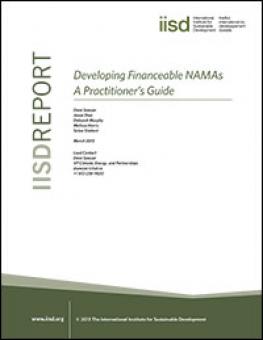
Developing Financeable NAMAs: A Practitioner's Guide
Nationally Appropriate Mitigation Actions (NAMAs) are fast becoming the climate finance vehicle of choice to help developing countries transition to low carbon, climate resilient futures.
Developing countries, their development partners and other actors in and around the United Nations Framework Convention on Climate Change (UNFCCC) are working to operationalize the concept to leverage domestic climate finance with bilateral and multilateral support, and through carbon markets.
To help operationalize NAMAs, the International Institute for Sustainable Development has produced an easy-to-use-guide to help practitioners successfully identify and prioritize financeable NAMAs.
The guidebook is a time saver, with easy-to-follow instructions based on real experience and a proven track record of success. IISD's climate change and energy team's step-by-step guide is based on its technical expertise and lessons learned from on work in Kenya, Bangladesh, Trinidad and Tobago, and Congo Basin countries including Democratic Republic of Congo and Rwanda.
The guide book offers a quick screen methodology to identify NAMA opportunities with potential for climate financing, and a deep screen methodology to analyze and determine the most appropriate development options to meet country-specific needs. And the process has been tailored to produce NAMA Concepts and Proposals that align with the requirements of the UNFCCC NAMA registry that will open this year.
The guide walks policy makers through all the steps needed to successfully develop NAMAs and demonstrate preparedness to access available funding.
The guidebook is part of IISD's effort to support low-carbon, climate resilient development in developing countries.
Participating experts
You might also be interested in
December 2024 | Carbon Minefields Oil and Gas Exploration Monitor
In November 2024, 23 oil and gas exploration licences were awarded across five countries, with Russia granting the licences that account for the largest portion of embodied emissions.
Increased Support Needed to Achieve India's Clean Energy Goals
India is on track to achieve many of its 2030 clean energy goals but needs to step up government support measures to accelerate the deployment of offshore wind, electric vehicles, and green hydrogen, according to a new report.
Budgeting for Net Zero
This study estimates the cost gap for battery energy storage systems (BESSs), offshore wind, solar photovoltaic (PV), electric vehicles (EVs), and green hydrogen (GH2) to inform government support.
Artisanal and Small-Scale Mining of Critical Minerals
This report examines the potential for artisanal and small-scale mining (ASM) to take an expanded role in the global supply of critical minerals.